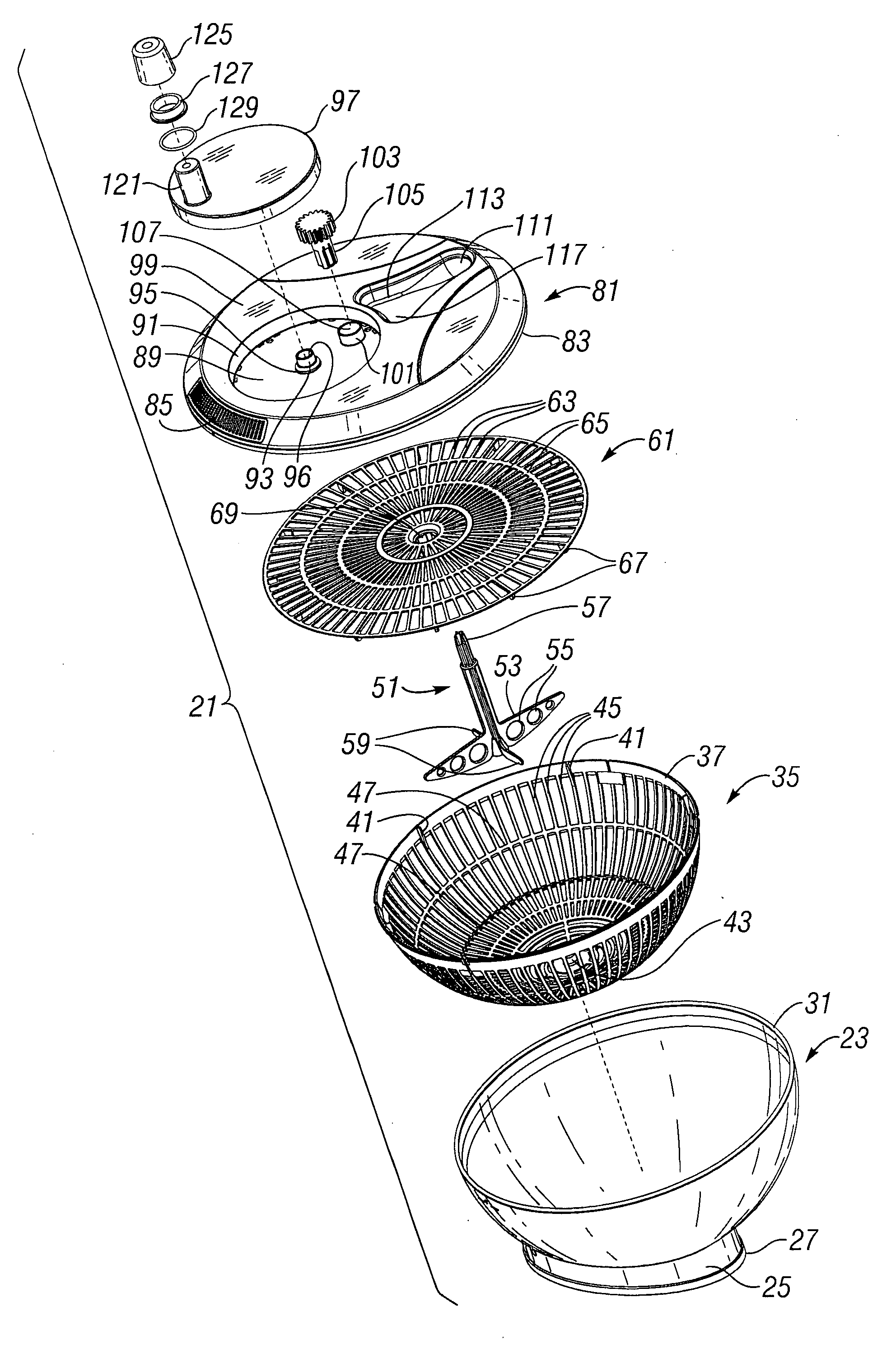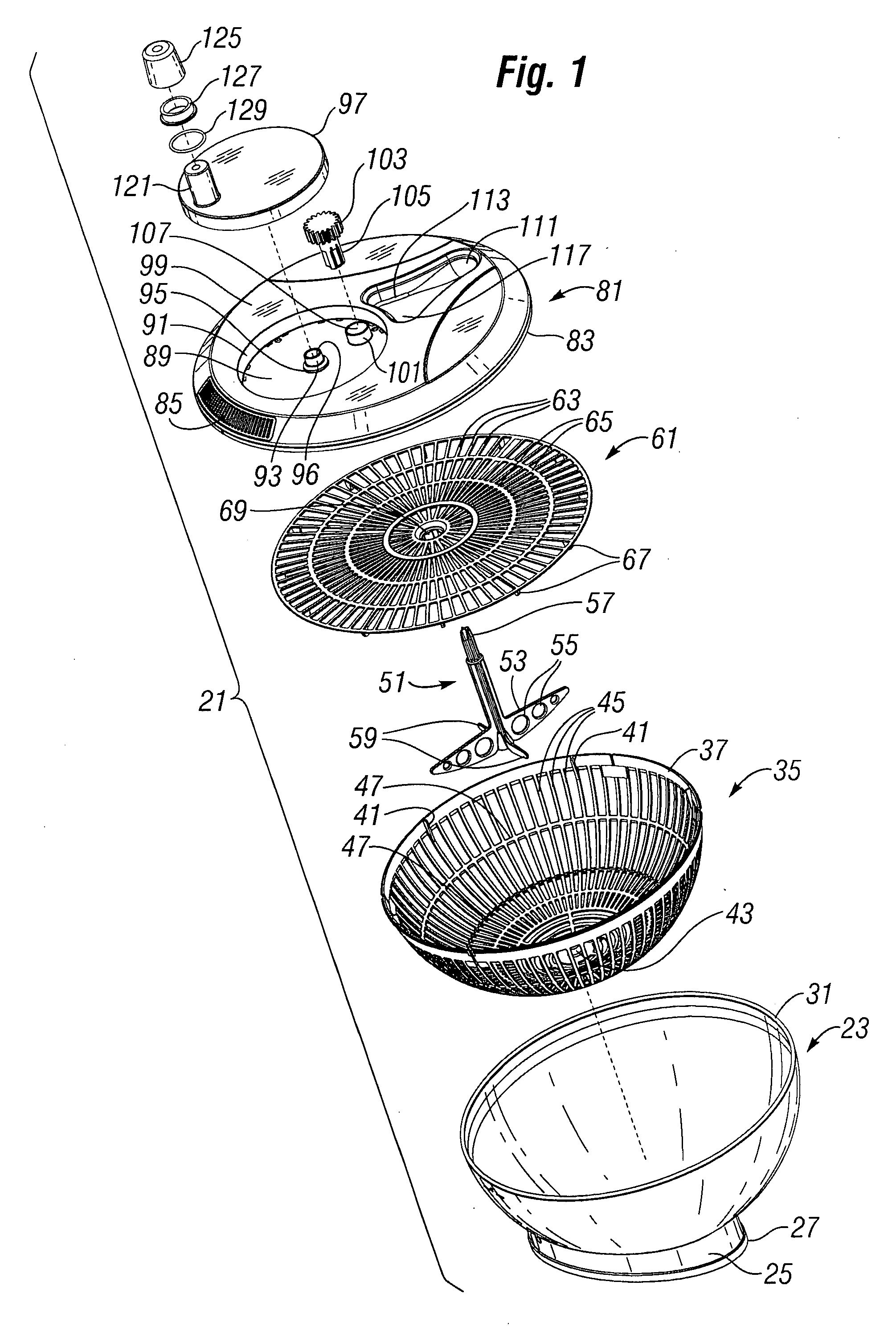[0008]The effect is to gently wash the contents in agitated water and allow the pesticides, herbicides and
dirt to flow away in the water
stream. For particularly dirty items, the user can stop filling the bowl when the
water level reaches a water fill line on the bowl. Gentle cranking of the
handle will then allow the contents to be soaked, agitated and washed with or without flowing water. The user can also tip up the bowl to empty the dirty water and then refill and repeat as necessary. For items that are generally rounded, e.g. potatoes, brussels sprouts etc., the angled bowl and gentle cranking leads to a gentle tumbling of the contents inside the basket that aids and speeds up the cleaning process. This is particularly useful for dirty items such as new potatoes. Any dense particles such as stones or grit may be allowed to collect at the bottom of the bowl and fall into a dirt trap that consists of recessed slots. This dirt trap stops the particles being flushed back into the items being washed by turbulence.
[0009]When washing has finished, the
excess water can be drained out via the outlet grille in the cover. The cranking handle can then be turned again to spin dry the contents. This is particularly suited to salad greens where a high speed can drive out a lot of
excess water. This water will collect at the bottom of the bowl between the bowl and the
spinning basket. Heavy particles will once again drop into the dirt trap slots. In one embodiment a
crank may be provided which will cause the basket to move at a slower speed when cranked in one direction and at a higher speed when cranked in the opposite direction.
[0010]The Salad, rice and other foods
washer and spinner can also be used for
herb washing and is facilitated for use for rice washing with a rice wash attachment. To facilitate
herb washing, a pair of clip in mesh panels allows the basket to be subdivided into compartments. Delicate or small items can be placed into these compartments for washing without fear of them being overly tumbled or getting mixed up with other items being simultaneously washed. Further, as the side partition forms a separate space at the outer part of the basket which will have more of an immersing and draining action as the basket turns.
[0012]Other optional features include the provision of a
brake function that may be provided to slow down the
spinning basket. This consists of a wear pad on the underside of the water inlet bottom face that can be brought into contact with a matching face on the basket lid by the user's pressing down on the top face. The
brake function can therefore be provided without the need for any extra components.
[0013]Dual or twin speed can be provided to operate without special switching, perhaps simply by reversing the direction of turn of the handle. Due to the
inertia and
viscosity of water, and the close proximity of the basket to the bowl, it is noticeably more difficult to
crank the handle when the basket is being forced to move through water during the washing cycle. Whilst it would be possible to reduce the
gear ratio to ease cranking, this would limit the effectiveness during spin
drying when the same
gear ratio limits the upper rotational speed of the basket. It is therefore advantageous to have a means to change gearing. Two methods are presented, both of which are allow a different
gear ratio depending on whether the handle is being cranked
clockwise or counterclockwise.
[0015]A second possible arrange may include dual or twin speed with floating gears. In this arrangement, both an internal and external gear ring are mounted on the drive disc but neither gear ring actual engages the drive gear. Instead there are a pair of small idler gears one of which is always driven by the external gear and can be swung into engagement with the drive gear and the other always in engagement with the internal gear and also able to be swung into contact with the drive gear. The two idler gears are both mounted on a common platform that rotates (floats) about the common centre of the drive disc and internal and external gears. The idler gears may be positioned on either side of the drive gear and spaced apart in such a way as to ensure that it is not possible for both of them to touch the drive gear simultaneously. When the drive disc is rotated in a given direction, one of the idler gears is urged into engagement with the drive gear whilst the other is pushed away by virtue of being on a common platform. The drive gear will then be driven by the drive disc by the engaged idler gear. If the rotation of the drive disc is reversed, the idler gear that was in engagement is immediately driven out of engagement and the other idler gear moves into engagement. As the internal and external gears have different numbers of teeth, the gear ratio is switched depending on whether the drive disc is being rotated
clockwise or counterclockwise. When the drive disc is released, the idler gears both move to a non engaged position so the rotating basket over runs freely.
 Login to View More
Login to View More  Login to View More
Login to View More 


